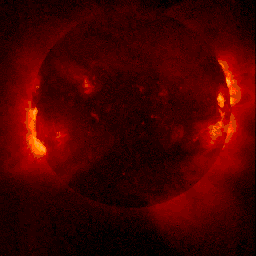The Sun

The Sun as seen in X-rays
(from the Yohkoh satellite)
The Sun is a star. It is a rather ordinary star - not
particularly big or small, not particularly young or old.
It is the source of heat which sustains life on Earth,
and controls our climate and weather. It is the closest star to Earth,
and the most closely studied. From it we have learned a great deal about the
physical processes which determine the structure and evolution of stars in
general.
Below we discuss the regions of the Sun's atmosphere which we can
observe and measure.
The Sun's Outer Layers
Only the Sun's outer layers, collectively referred to as the solar
'atmosphere', can be observed directly. There are distinct regions to
the solar atmosphere: the photosphere, the chromosphere, and the corona.
These three regions have substantially different properties from each other,
with regions of gradual transition between them.
The Photosphere
The Sun has basically the same chemical elements as found on Earth.
However, the Sun is so hot that all of these elements exist in the
gaseous state.
There is not really a "surface" to the Sun. Think of it this way: the
Sun is a bunch of gas which gets denser and denser as you move from space
toward the solar core. The photosphere would then represent the depth at
which we can see no deeper toward the core. Think of what a thick cloud
looks like when you look down on it from an airplane - it looks solid,
but it isn't.

The Parts of a Star |
|
The Sun's atmosphere changes from being transparent to being opaque over
a distance of only a few hundred kilometers. This is remarkable given the
size of the Sun, and represents such a huge change that we often think
of it as a true boundary. When we speak of the size of the Sun, we usually
mean the size of the region surrounded by the photosphere. The photosphere
is slightly different from one place on the Sun to another, but in general
is has a pressure about a few hundredths of the sea-level pressure on
Earth, a density of about a ten-thousandth of the Earth's sea-level atmospheric
density, and a temperature in the range 4500-6000 Kelvin.
The Chromosphere
The gases which extend away from the photosphere make up the
chromosphere. These gases are transparent to most visible radiation. The
chromosphere is about 2500 km thick. The density of the gases decreases
as you move away from the photosphere into the chromosphere, but the
temperature increases! From the bottom to the top of the chromosphere,
the average temperature goes from 4500 to 10,000 Kelvin! Needless to say,
this rise was not anticipated by scientists when they first measured it.
Throughout the rest of the Sun, temperature decreases as you move
further away from the core.

The Solar Corona seen during
a total
eclipse |
The Corona
The chromosphere merges into the outermost region of the Sun's
atmosphere, the corona. The corona extends for millions of miles into
space above the photosphere. Usually, we cannot see the corona
because of the brightness of the photosphere. However, during a
total solar eclipse, the corona shines
beautifully against the dark sky. The corona has a density about
0.0000000001 times that of the Earth's sea-level atmosphere. It is very
hot - millions of Kelvin. Because of this high temperature, the bulk of
the radiation from the corona is emitted at ultraviolet and X-ray
wavelengths. Magnetic fields on the Sun seem to play an important
part in heating the
gas to such a high temperature. However, the exact way that this happens
is not well understood. The image you see to the left was taken during a
solar eclipse in 1980; light from the photosphere is blocked out by
the Moon (the dark disk).
|
A Few Other Solar Features
The Solar Wind
The solar wind is nothing more than a stream of charged particles flowing
outward from the Sun with an average velocity of about 400 km/sec. It is a
natural consequence of the Sun being so hot - the corona gas has too
much energy to be gravitationally bound to the Sun.
Sunspots and Their Cycle
Sunspots are cooler regions on the Sun's photosphere (about 1500 K cooler)
and so appear to be darker than the photosphere. A given sunspot can have a
lifetime ranging from a few hours to a few months. It consists of two parts
- the dark inside region called the umbra and the surrounding less dark
region called the penumbra. Their sizes vary over a wide range, with a few
having been measured to be 50,000 km in diameter!
A German amateur astronomer, Heinrich Schwabe, published a paper in 1851
which stated that the number of sunspots visible on average varied with
a period of about 10 years. This conclusion has been substantiated by
observations over the 140 years since. The period of repetition on
average is 11.1 years, but has been as short as 8 years and as long as
16 years.

A plot of the relative number of sunspots
as a function of time from 1645 until 1991.
|
During the maximum of the cycle, more than 100 sunspots can be seen on the
Sun at once. During the minima, the Sun sometimes has no spots at all.
This cycle is closely related to the magnetism of the Sun. In fact, it is
the changing magnetic field of the Sun which governs many aspects of
solar activity.
|
